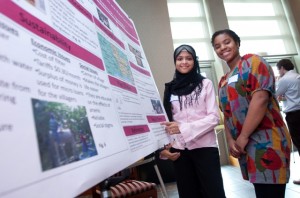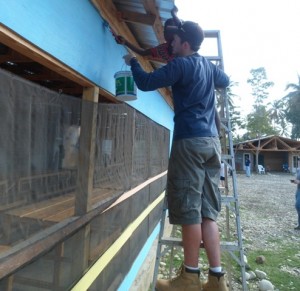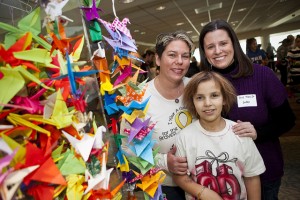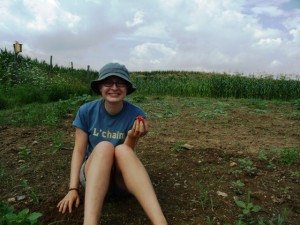With their Save Me from Arsenic project, civil engineering major Thafhim “Muna” Siddiqua ’13 (Silver Spring, Md.) and international affairs major Taneesha Tate-Robinson ’13 (Bowie, Md.) are helping to remove arsenic from water in Bangladesh. They received a $10,000 Projects for Peace grant and will travel to the city of Barisal this summer to test tube wells and educate the villagers on the symptoms of arsenic poisoning.

Thafhim “Muna” Siddiqua ’13, left, and Taneesha Tate-Robinson ’13 presented their project at Lafayette’s Community Based Learning and Research expo.
Siddiqua, who was born in Bangladesh, says, “By educating the village, we hope to prevent cases of severe illness and even death due to untreated cases of arsenicosis and their inability to obtain safe drinking water. At the end of the project, we expect to have a well-trained village in Barisal that will be able to identify individuals with arsenicosis and have a committee able to improve arsenic problems in the village.”
The project falls within Lafayette’s Community-Based Learning and Research (CBLR) initiative, which provides the infrastructure to support academic service-learning and community-based research at the College. It enhances the efforts of faculty across all disciplines whose teaching and research benefit the community. It also allows students to apply what they have learned while helping local and global communities solve real-world problems.
Each year, the College hosts a CBLR Expo, showcasing ways in which faculty, students, and administrators are partnering with nonprofit agencies, businesses, civic organizations, and local governments to enhance learning and improve communities, locally and around the world.
“Through the CBLR initiative, a faculty instructor designs a community-based, experiential component in partnership with a community organization to deepen students’ understanding of the course content. Volunteer work also can provide an opportunity to learn something, but the learning depends entirely on the volunteer’s ability to glean meaning from his/her own experience,” says Hannah Stewart-Gambino, dean of the College.
With the wide variety of experiential learning opportunities available, CBLR is an important part of the Lafayette education. Real-world issues force students to make multidisciplinary connections.

Alternative School Break students help build a house in Haiti.
This January, Tyler Germanoski ’12 led an interdisciplinary team of 11 students on a trip to Haiti through Lafayette’s chapter of Alternative School Break. Working with the Community Coalition of Haiti, which aims to meet the basic needs of the poor, the students built a house for a widower who had lost his leg in the 2010 earthquake, did electrical work for an operating room at a health clinic, visited orphanages to play games with children, and distributed water filters.
“One of the things that was difficult about our trip to Haiti was seeing how beautiful it is and how amazing the people are, but having to accept the reality of the poverty that they live with,” Germanoski says. “The trip for me reaffirmed that although you cannot expect to fix everything, it should not stop you from working to make any difference that you can.”
Students are also stepping out into the local community by getting involved with everything from libraries to gardens to supporting pediatric cancer patients.
For the past two years, a team of students has been working with Mary Jo Lodge, assistant professor of English, on the National Crane Project. Inspired by the life of 10-year-old David Heard, who died in February 2011 from cancer, the project continues his dream of giving hope to other pediatric cancer patients through the construction and distribution of colorful crane mobiles.

Susan Heard (left), David Heard, and Mary Jo Lodge, assistant professor of English, at a crane stringing party held at Lafayette.
Heard got the idea for the project after Lodge invited him and his parents, Susan and Tom Heard ’91, to attend a play she directed at the College; A Thousand Cranes. The play is based on the true story of a 12-year-old girl who attempts to fold 1,000 cranes after she develops leukemia following the atomic bombing of her hometown of Hiroshima, Japan, during World War II. Japanese legend holds that anyone who folds 1,000 paper cranes will be granted one wish.
Lafayette and the community embraced David’s cause, folding thousands of cranes and installing mobiles at three area hospitals and one in California before he died. Twelve more have found homes across the country since then, says Lodge, including one at Lehigh Valley Hospital-Cedar Crest created by employees from Crayola. To date, more than 100,000 cranes have been folded by people across the country.
Chris Phillips, assistant professor of English, and neuroscience major Gavin Jones ’14 are creating a database that shares authoritative records of American reading based on the original records of the Easton Library Company (precursor to the Easton Area Public Library). Dating from the early 1800s, the project reveals the reading habits of Easton citizens 200 years ago and sheds light on sociological and anthropological revelations.

Julia Seidenstein ’14 at the Lafayette Organic Garden
On campus, geology major Julia Seidenstein ’14 (Lawrenceville, N.J.) has been testing out some organic methods of pest control at the Lafayette Organic Garden, trying to find a way to deal with pesky squash bugs, squash vine borers, and cucumber beetles that gave Lafayette gardeners trouble last year. She found that handpicking the bugs, using row covers until the plants start to flower, spraying with a soap-and-water mix, and spraying with organic chemicals like neem oil are all successful organic pest control techniques.
Seidenstein says, “These are all things I could do right away, but there are also methods that are a longer process. Building soil health, for example, will help with a plant’s ability to resist or tolerate pests. This is something we are working on in the student garden. Organic is less about a quick fix and more about long-term and sustainable solutions.”
Other CBLR programs that students have been involved with:
- Tax assistance for low-income residents
- Supporting local teen parents
- Engineering education for grades K-12
- Bushkill Creek Nutrient Study
- Education program for inmates at Northampton Country Prison
- America Counts at Easton Middle School
- Lafayette Initiative for Malagasy Education
- Supporting local nonprofits
- Improving the viability of local fish farming
- Creating a sense of place through community arts



